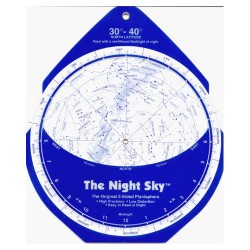[/caption]
Astronomy is a wonderful hobby that’s incredibly easy to get started with. That’s because all you need is your eyes, some reasonably dark skies and star chart to learn your constellations. Better equipment comes later, of course, when you buy a set of binoculars or a small telescope. But let’s just start with the star chart.
There are some incredible resources for star charts out there. My all time favorite, the one that taught me my constellations, and helped me make my first observations with a telescope is Nightwatch: A Practical Guide to Viewing the Universe, by Terence Dickinson. This is a 192-page spiral bound book that contains detailed charts of the sky for different seasons. You flip it open to the region of the sky that you want to study, find some reference stars and then start exploring.

If you want something a little smaller and more portable, you might consider a planisphere. This is circular wheel with a window cut out of it to show the sky. You rotate the planisphere to your current month, and it shows you the constellations that will be visible in the sky. The problem with a planisphere is that they aren’t very detailed and only show the brightest stars and constellations. Here’s a link to a planisphere that’s good if you live above the 30th parallel. There are others for more southern skies.
Let me guess, you’d like something free that you can just print off from the Internet. No problem, there are plenty of resources out there.
The National Research Council of Canada has an online planisphere that you can customize to your current month to see what’s up in the sky. They also have a printable version that you can make for yourself.
One of my favorite resources is Skymaps.com. Each month they release a new printable sky chart for both the Northern and Southern hemispheres. It also comes with a monthly sky calendar and a great list of objects to see with binoculars, telescopes or just your eyes.
Finally, if you want to get really specific, the TAU Astronomy Club has a monthly sky map for every location on Earth. You enter your latitude and longitude, and the system generates a sky chart specific to your skies. Very handy.
So, you’ve got no excuse. Get a sky chart, head outside and appreciate the wonder of the night skies.
If you’d like more information on stars, check out Hubblesite’s News Releases about Stars, and here’s the stars and galaxies homepage.
We have recorded several episodes of Astronomy Cast about stars. Here are two that you might find helpful: Episode 12: Where Do Baby Stars Come From, and Episode 13: Where Do Stars Go When they Die?

